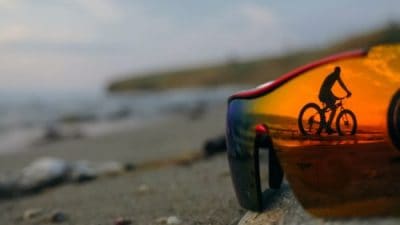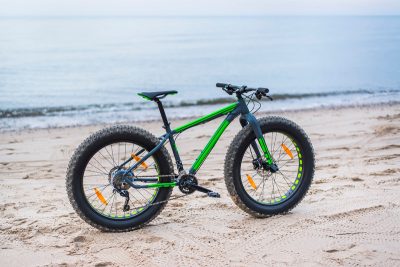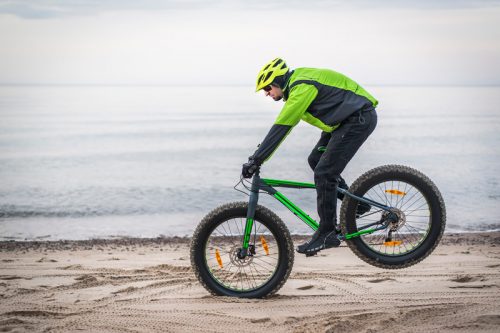Depending on where a person lives and where they like to ride their bike, people tailor them for any type of terrain. Riding on the beach is an adventure, and the right bike is needed to have success.
Too often, people are out there with beach cruisers and other bike options that don’t do that much good. As fat bikes become more and more prevalent, people are finding out that this is the best option available.
In this article, the goal is to help people customize their particular fat bike so that it is ready for the beach. Only do this if the plan is riding quite frequently on the beach or soft sand only, because otherwise, it is going to take a lot of changes every single time. This is the way to maximize performance, make peddling easier and enhance the entire experience.
Most people ride on the beach for enjoyment, but it’s a great workout as well. There is a difference between riding for exercise and struggling against the bike though. No one wants to be fighting against the bike and making it harder than it has to be.
What to Expect When Riding on the Beach

Walking or running on the beach is a very difficult task, especially when the sand is not very firm. So it should come as no surprise that when trying to ride a bike on that same type of sand, it can be a struggle as well. The best way to describe it is that it feels like twice the effort needs to be put in to only go half the normal speed on standard pavement.
The best conditions for any type of bike is going to be hard and smooth. That allows the tires to roll without a little resistance, and a person can build up some pretty impressive speeds. Not only that, but coasting on the bike is pretty easy once some momentum is picked up.
No one should be expecting to set any type of speed records on the beach, even if the sand is extremely firm. It’s more of a workout, an experience, and a way to take in the coast without having to slowly walk or run up and down.
Having a fat bike to rely on is very beneficial because even if the same shoreline is used as a track every single day, it’s going to vary depending on the weather conditions. On some days, it can be very firm, which will make the ride great for the most part. At other times, it might be rocky or very soft, which will make it a challenge.
Most people ride Fat Bikes on the beach for one of three reasons.
It is the Closest Location for a Fat Bike Adventure
During a busy day, it is hard to get to a location that might be 30 minutes away just to enjoy riding on a fat bike. Those who live in coastal towns might find this to be the closest challenge. It’s not generally going to have many hills at all, but it offers so many other challenges along the way.
If the beach is the closest area to ride, why not ride there consistently? Some coastlines turn into workout tracks every single day, so a fat bike won’t stand out like a sore thumb.
The Scenery
The beach is not for everyone, but most appreciate the scenery when they are visiting. If the wind is coming off the water just right, and the temperature is perfect, few riding conditions can compare. Some people can’t get enough of it, and they ride on the beach as often as possible. Others will treat this as a bit of a treat. Maybe they’re on vacation, or they are driving to the coast to enjoy the scenery a couple of times a year.
Just remember that while looking around and taking everything in, it is also important to pay attention to other riders, walkers, and runners. The noisy water crashing up against the sand might make hearing people approaching a little more difficult. No one wants an accident at such an enjoyable location.
The Challenge
Riding a fat bike on the beach is a unique challenge that isn’t found anywhere else. Even on dirt trails and mountains, sand is not the same as here. Most consider it some of the toughest terrain to ride a fat bike on, and some like that challenge. Many people liken it to riding an indoor stationary bike with different resistance settings. The sand prevents a person from ever having the opportunity to coast.
Just like a fixed gear bike, a person must be constantly putting in work for the bike to keep moving. This challenge will end up helping a person burn more calories in the same amount of time.
Prepare the Tires for the Beach

Most fat bike tires are inflated incredibly low compared to other bike tires out there, and a beach is where a person should be dropping it down to another level altogether.
If the ride is going to be entirely on the beach, going as low as four or five PSI is probably going to give a person the best experience. Some people might think this is crazy, but play around with different tire pressure and see how it feels.
Very low tire pressure is going to get a person better flotation when riding. There is a larger contact area to the ground, and this helps to smooth out the ride a little bit. If the tires are not super inflated, they won’t sink into the beach.
Any type of width for a fat bike tire will do, but when trying to pick between two different options, go with the wider tire. Again, this increases the contact area, and it prevents the bike from sinking in like some of the smaller options. Even if a road bike had tires inflated very low, they would still likely sink into the beach because they are so skinny.
The only problem with dropping super low is that it can be tough when transitioning to a harder surface. If the ride is going to be partly on the beach, and partly on a trail with pavement, bump it up a few PSI. This will give any rider a little bit more control when they are on the harder surface. There is also the opportunity for some people to stop and give the tires a bit more air, but some don’t have the patience for it.
Click here for a list of the Best Fat Bike Tires for Beach Riding!
Find the Best Part of the Beach to Ride On
Fat bikes do best on slightly firm sand, so try to get up near the shoreline to experience that type of track. If the waves are coming in strongly, it might be tough to get too close, but fat bikes can handle a little bit of water. Just make sure to avoid too much water, because sand can start to spin up and do some damage to the fat bike in the long run. Not only that, but saltwater is notorious for causing a considerable amount of rust.
Try to stay away from the extremely soft sand as much as possible. While it might be a very good challenge, a person isn’t going to be able to ride too long. This is also where people tend to lay down and sprawl out a bit, so it’s just a hassle in general to find a good path.
The type of sand doesn’t matter too much from a fat bike perspective. In fact, some of the most pristine beaches in the world have very fine sand, which can be tough to deal with when bone dry. Every sand packs much better with some water mixed in.
Pick the Right Time to Ride on the Beach
As far as the time of year, it depends on where a person resides. In warmer cities, it’s common to find fat bike riders every month of the year at the beach. Up north, some like the challenge of very cold, windy and sometimes snowy conditions. Fat bikes work for any condition imaginable, and one good thing about riding on the beach during cold weather is that there will not be many other people out there.
For the time of day, most like to go when the tide is starting to fall. That means less of a hassle dealing with the water coming up too much, and the ground seems to be about as firm as one could expect. When the tide dies down, the wind usually dies down as well. Windy conditions are inevitable to a certain degree on the coast, but people usually try to refrain from being there when it is too windy. It is just one more thing that hinders the performance of a rider, and ultimately, it leads to a ton of frustration.
Take Care of the Bike Post-Ride
Fat bikes are notorious for being able to take anything thrown their way. They are indeed extremely durable, and people love that they can go anywhere. To prolong the life of the fat bike, it needs to be properly taken care of after a ride. When riding on sand, it is especially important.
Sand can do a lot of damage to the drivetrain and brakes if not cleaned off properly. Even if people do everything correctly, some of the things on the bike will wear out a little bit faster than in other conditions. Without cleaning things off and taking care of the fat bike, its lifespan reduces significantly.
If riding on sand is a priority, some bike components are built with durability in mind. In fact, some are designed specifically for the sand, which will help a person save money in the long run.
There are a few things a person can do if they want to make sure that they avoid too much sand getting caught up in the bike. One thing to remember is to open up a little bit of space on the bike brakes. The more space that is available, the easier sand can move through and not get stuck in weird places.
It also pays to spray a little bit of lube on the chain, but only at the right time. Some people think they should put chain lube on before and after, but some complications pop up when doing it before. When a typical spray lubricant is put on, it dries up a bit and can make its performance not as strong. It’s good for care over the long run, but right before it doesn’t make a ton of sense.
If the chain is brand new, make sure it is properly greased and has spray lube on it before going on any journey. It is going to make it much less likely that sand will start to stick to certain areas. At times, it can certainly feel like sand is impossible to remove completely.
The quickest way to give the entire bike a quick cleanse is to use a water spray. Make sure that it is fairly low pressure, so that it doesn’t do any damage to the bike, the paint, the components or anything else. Not only that, but sand can sometimes be pushed into hard to reach areas if the pressure is too high. By using low pressure, everything can fall off the bike pretty naturally, and it doesn’t require anything more than letting the bike completely air dry.
After it starts to dry a bit, spray the chain so that it is dry and ready to go for the next time a ride as scheduled. Storing the bike in a dry, climate-controlled place is the best way to take the right amount of care. A person should avoid putting a fat bike outside for an extended period of time. This leads to rust, and also increases the chance of it being stolen. Most people are spending $1000 or more on a good fat bike, so why risk it?
Upgrade a Bike for Better Performance on the Beach (Three Ways)

Many people who ride their fat bikes on the beach consistently will make a few altercations for a more enjoyable experience. Remember, that should only be done if this is the primary way that the bike will be used. Making a ton of changes only for a small percentage of the time makes no sense.
Invest in a Better Seat
Take a look at any beach cruiser, and one of the defining features is a nice, cushioned see. Fat bike riders probably don’t want to go to that extreme, but they could get away with it if they want to. Most people are not going to go fast enough on the beach to get out of the saddle. Not only that, but unless the person is competitively riding, they are not going to be attempting to set any speed records.
Just a little bit more cushion with the seat will make everything feel better. Of course, if the bike already does not have a carbon set up below the seat, that might be a worthy upgrade as well. It will smooth out the ride and make it extremely comfortable.
Try out Clipless Pedals
A lot of this will come down to personal preference, but the majority of fat bike riders on the beach tend to use pretty standard pedals. That means not clipping in, and having a good amount of surface area to put the seat. The good news is that these are usually very inexpensive, even for high-quality pedals.
Of course, if a person does insist on clipping in on the beach, make sure to be aware of the surrounding area. At times, the beach can get very crowded, so clipping in could be a frustrating experience. If a person is constantly having to stop or change in direction at the last moment, it can cause some trouble.
Tacky Grips
The humidity tends to be pretty high at times near the beach, and that can lead to some sweaty hands. To improve the grip, don’t be afraid to upgrade to some tacky grip options. It also helps to get some added padding with new grips, because there might be some sudden stops or changes in direction. The standard grip on a normal fat bike will probably do just fine, but it’s a pretty simple and inexpensive upgrade if it personally wants to.
If the grip is a concern, there are other options available. Some people will carry chalk with them on longer rides, and apply it to their hands or the grip from time to time. They are also gels that do pretty much the same thing. The more often the grip is switched out, the better it will perform.
One final option is to wear gloves. Some people don’t like wearing gloves because they get a little too warm for their liking. However, they fight against grip issues, reduce the chance of blisters and protect all parts of the hands. If there is an accident, having gloves on can prevent a person from bleeding or having a fairly big injury.
Click here for one of my favorite Cheap Grips from Amazon.
Where are Some of the Best Places to Ride a Fat Bike on the Beach?
No matter what type of challenge rider is up to, there are numerous destinations to explore with a fat bike. The important thing is the fine areas that are very welcome into having bikes near the shoreline, because some cities prohibit it.
The three areas below are all turning into very popular destinations for people living in North America. Some people like going to these areas on vacation anyway, while others who are really into fat biking will travel specifically for new terrain to tackle. Traveling for biking opportunities is more popular than a lot of people realize.
San Diego, California
It doesn’t take much to convince the average person to make a trip to San Diego. It is one of the most beautiful cities in not only the United States, but the entire world. Fat biking is catching on, and the weather is nice enough to easily bike 12 months out of the year.
Perhaps the best beach for fat biking is Coronado Beach. The locals are very into fitness, and there will be a lot of fat bikes out there for people to feel more at home. There are a couple of places that will offer rentals once a person arrives via the Coronado Ferry.
When riding on the beach, a person can get to the Mexican border if they want. There is a lot to explore, but most people insist that they take in at least one sunset in while they are there. It makes for some great memories, and just an enjoyable time all around. Every person who enjoys staying fit on a fat bike should make at least one visit to the city of San Diego.
Homer, Alaska
Anyone who has been to Alaska over the last few years has probably seen fat bikes. They are designed for the typical Alaskan terrain, handling anything thrown their way at any time of the year.
While there are many places to explore in Alaska, one coastline that stands out is in Homer. Like San Diego, it faces the west, so the sunsets will be there for sure. There are places to stop along the way for rest and relaxation, and it’s just an overall laid-back vibe.
Of course, going in the summer is the best for people who aren’t used to riding in the cold. Not only that, but there is limited daylight during the winter, so it just makes for a challenging experience overall.
It is one way to get a blend of sand and snow, which is the challenge some people are looking for. It snows pretty frequently during the winter months, covering the ground for sometimes months at a time. There are plenty of miles to explore in Homer, and the surrounding area is underrated for a normal vacation as well.
Daytona Beach, Florida
Known for its auto racing and spring breaks, Daytona Beach has a strong reputation as the fat bike capital of the southeastern United States. Not only do they allow fat bikes to go on the beaches, but cars can be driven there as well.
Since there are so many people who are just visiting the area, renting a fat bike is very easy. It’s one of the best ways to see a lot of the Florida coastline without having to spend too much money. For locals, it’s a way to get some great exercise 12 months out of the year.
Can a person get in trouble for riding a fat bike on the beach?
Before going on a new track, make sure to find out whether or not bicycles are allowed on the beach. The majority of beaches do allow them, but there might be some areas where they are prohibited.
Most of the time, if a person is caught riding a bicycle in an area where it is prohibited, they will only get a soft warning. It’s still not worth the hassle of trying to go to a particular area where they are prohibited. Usually, it is for some reason, such as too many pedestrians on foot in the area, or city ordinances.
Even if fat bikes are completely allowed, a person should always use proper etiquette. Make sure to pass on the left when possible, and treat the coastline much like a bike trail. If a person fails to do that, they are likely going to get more than a few ugly looks from those walking or running.
How Popular are Fat Bikes on the Beach?
Fat bikes are definitely catching on in coastal areas, as people are realizing just how more efficient they are compared to beach cruisers. Most beach cruisers are fairly limited with gears, how much they weigh and the overall shape for that matter. Fat bikes are more of a performance style, and it just makes more sense to get around town with one.
Prices are coming down to the point where people are willing to spend the money and upgrade to a fat bike as well. If the majority of riding is being done on the sand, it’s a no brainer. Mountain bikes might do an adequate job on the sand, but the added width of the tires with a fat bike will make a pretty big difference. There is also more of an opportunity to add studs to the tires if they are needed, although most people go without unless they are in snowy conditions.
Don’t be surprised if fat bikes continue to close the gap between them and beach cruisers. It is easier to buy a beach cruiser since they are found pretty cheaply, but they are going to last nearly as long. Most studies show that they are going to come out to roughly the same over the long run.

